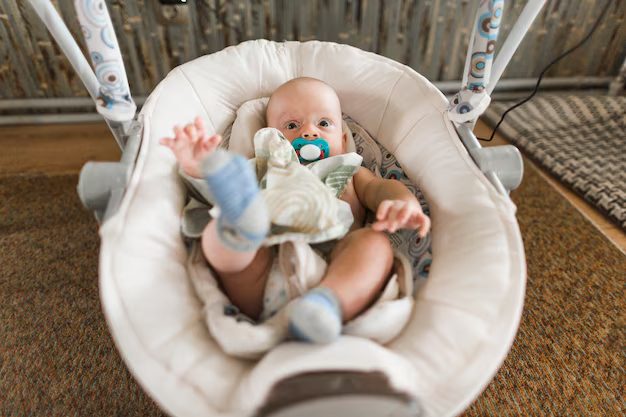Baby swings are essential for ensuring the comfort and safety of infants while providing parents with a convenient way to soothe their little ones. Designed to mimic the gentle rocking motion babies experience in the womb, these swings help calm fussy infants, support better sleep, and provide entertainment. Beyond their soothing capabilities, baby swings also play a role in a child’s early development by stimulating their senses and encouraging relaxation. However, safety remains a top priority, making it crucial to choose a swing with secure features and appropriate usage guidelines.
Understanding Baby Swings
What Is a Baby Swing?
A baby swing is a specialised seat designed to move in a rhythmic motion, providing comfort and entertainment for infants. Many models feature adjustable speed settings, built-in lullabies, and vibration functions to soothe babies. Equipped with a sturdy frame and safety harnesses, baby swings offer a secure environment while parents attend to daily tasks.
Why Baby Swings Are Important for Infant Development and Comfort
Baby swings serve more than just a functional purpose—they also contribute to an infant’s development. The gentle rocking motion can help soothe babies with colic or difficulty settling down, while built-in toys and sounds can enhance sensory stimulation. Additionally, the comfort provided by a baby swing can encourage better sleep patterns, reducing stress for both parents and infants.
The Importance of Safety Features in Baby Swings
When selecting a baby swing, safety should be the foremost consideration. Features such as a five-point harness, sturdy frame, and non-slip base help prevent accidents and ensure the swing remains stable during use. Proper weight limits and reclining positions are also crucial, as newborns require extra head and neck support. By choosing a model that meets safety standards, parents can create a secure and comfortable environment for their child.
Things to Look for When Buying a Baby Swing

Safety Features
When buying a baby swing, safety should be the top priority. A secure harness system, preferably a five-point harness, is essential to keep the baby safely strapped in and prevent falls. A sturdy base with non-slip grips ensures stability, reducing the risk of tipping. Adjustable reclining positions are important, particularly for newborns who require extra head and neck support. Parents should also consider weight and age recommendations to ensure the swing is suitable for their baby’s development stage. Additionally, choosing a swing that meets certified safety standards guarantees compliance with regulations, providing peace of mind that the product has undergone rigorous testing for safety and durability.
Comfort Features
In addition to safety, comfort is a crucial factor when selecting a baby swing. Soft, padded seats with removable and washable covers provide a cosy and hygienic environment for the baby while ensuring easy maintenance for parents. Multiple swing speed settings allow for adjustable motion, catering to the baby’s individual preferences and soothing needs. Many models also feature vibration modes and built-in sounds, such as lullabies or nature sounds, to help calm and entertain the baby. For added convenience, compact or foldable designs make storage and transport easier, allowing parents to move the swing effortlessly between rooms or take it along when travelling.
How to Maintain the Safety and Comfort of Your Baby’s Swing
Cleaning and Maintenance Tips
Regular maintenance is essential to keep the baby swing in top condition. Parents should:
- Wipe down the frame with a damp cloth to remove dust and dirt.
- Check for loose parts or frayed straps before each use.
- Wash fabric covers according to manufacturer instructions to maintain hygiene.
- Ensure batteries or power connections are working properly for electronic features.
Safety Checks and Routine Inspections
Conducting frequent safety checks helps prevent potential hazards. Parents should:
- Verify that all straps and buckles are securely fastened before placing the baby in the swing.
- Inspect the swing’s motion and speed settings to ensure smooth operation.
- Keep the swing on a flat, stable surface to prevent tipping.
- Avoid placing the swing near sharp objects or other furniture that could pose a risk.
Proper Usage and Positioning for Maximum Comfort
To ensure the baby’s comfort and safety, follow these best practices:
- Always position the swing on a level surface and away from potential obstacles.
- Use the appropriate reclining setting based on the baby’s age and development stage.
- Never leave the baby unattended while they are in the swing.
- Limit swing use to recommended timeframes to prevent over-reliance on motion for sleep.
Conclusion
Choosing a high-quality baby swing is an investment in both comfort and safety for your little one. By selecting a model with essential safety features, adjustable comfort settings, and easy maintenance options, parents can provide their babies with a soothing and secure space to rest and play. However, responsible use is just as important—regular safety checks, proper positioning, and moderate use ensure that baby swings remain a beneficial addition to an infant’s routine without posing risks.
By understanding the various options available and prioritising safety, parents can confidently choose the best baby swing for their child’s needs, ensuring a happier and more comfortable experience for both the baby and the caregiver.
